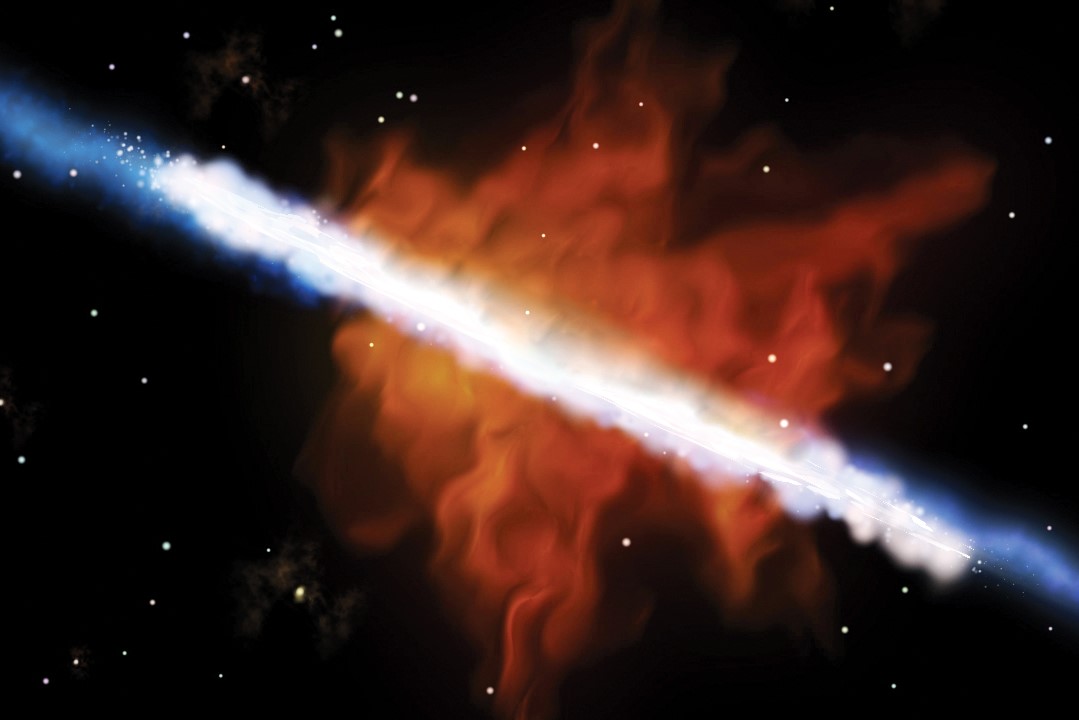New stars create space pollution, research confirms

The team lead by Swinburne and Oxford researchers have made the first ever observations of the entire process of new stars polluting the universe around it, confirming a major prediction of galaxy theory. Image credit: James Josephides at Swinburne Astronomy Productions
In summary
- New research confirms that newly-created stars pollute the cosmos, releasing huge amounts of material back into the universe
- To make the discovery, a team of astronomers led by Swinburne’s Associate Professor Deanne Fisher used new imaging technology to study a galaxy 500 light years away
- Swinburne is the only Australian university with access to the WM Keck Observatory in Hawaii, which was used to make the discovery
Swinburne researchers studying a galaxy 500 light years away have revealed how newly-created stars pollute the cosmos.
A team of astronomers, co-led by Associate Professor Deanne Fisher at the Centre for Astrophysics and Supercomputing at Swinburne University and the University of Oxford’s Dr Alex Cameron, has used a new imaging system at the WM Keck Observatory in Hawaii to confirm that what flows into a galaxy in the process of star-creation is a lot cleaner that what flows out.
Until now, the composition of the inward and outward flows into galaxies could only be guessed at.
This research by the ARC Centre of Excellence for All Sky Astrophysics in 3 Dimensions (ASTRO 3D) is the first time the full cycle has been confirmed in a galaxy other than the Milky Way.
“Enormous clouds of gas are pulled into galaxies and used in the process of making stars,” says Professor Fisher.
“On its way in it is made of hydrogen and helium. By using a new piece of equipment called the Keck Cosmic Web Imager, we were able to confirm that stars made from this fresh gas eventually drive a huge amount of material back out of the system, mainly through supernovas.
“But this stuff is no longer nice and clean – it contains lots of other elements, including oxygen, carbon and iron.”
Observing future galaxies
Swinburne is the only Australian university with guaranteed access to the world's largest and most productive optical/infra-red telescopes — the twin Keck Observatory telescopes located near the summit of Mauna Kea, Hawaii.
To make their findings, the researchers focused on a galaxy called Mrk 1486, which lies about 500 light years from the Sun and is going through a period of very rapid star formation.
The elements that were found in the expulsions – known as “outflows” – comprise over half the Periodic Table and are forged deep inside the cores of the stars through nuclear fusion.
When the stars collapse or go nova the results are catapulted into the Universe. Here they form part of the matrix from which newer stars, planets, asteroids and, in at least one instance, life emerges.
Mrk 1486 was the perfect candidate for observation because it lies “edge-on” to Earth, meaning that the outflowing gas could be easily viewed, and its composition measured.
“This work is important for astronomers because for the first time we’ve been able to put limits on the forces that strongly influence how galaxies make stars,” says Professor Fisher.
“It takes us one step closer to understanding how and why galaxies look the way they do – and how long they will last.”
The research is published in The Astrophysical Journal.
Other scientists contributing to the work are based at the University of Texas at Austin, the University of Maryland at College Park and the University of California at San Diego – all in the US – plus the Universidad de Concepcion in Chile.
-
Media Enquiries
Related articles
-

- Astronomy
- Science
Swinburne appoints new Director of Innovative Planet Research Institute
Leading geodesy expert, Professor Allison Kealy, has been appointed as the inaugural Director of Swinburne University's Innovative Planet Research Institute.
Monday 22 April 2024 -

- Astronomy
- University
OzGrav 2.0: A ‘new era of astrophysics’ launched at Swinburne
The next phase in the world-leading ARC Centre of Excellence for Gravitational Wave Discovery, dubbed 'OzGrav 2.0', launched this week at Swinburne University of Technology.
Wednesday 17 April 2024 -

- Design
- Astronomy
- Technology
- University
Swinburne ‘Rock Muncher’ takes part in Australian Rover Challenge
A multidisciplinary student team from Swinburne University of Technology competed in the 2024 Australian Rover Challenge held in Adelaide, South Australia.
Thursday 11 April 2024 -
.jpeg/_jcr_content/renditions/cq5dam.web.256.144.jpeg)
- Astronomy
New JWST observations reveal black holes rapidly shut off star formation in massive galaxies
New research showcases new observations from the James Webb Space Telescope that suggest black holes rapidly shut off star-formation in massive galaxies by explosively removing large amounts of gas...
Tuesday 23 April 2024 -

- Astronomy
NASA’s JWST probes an extreme starburst galaxy
An international team of astronomers has used NASA’s James Webb Space Telescope to produce the highest-resolution image of spectacular exploding stars ever seen...
Thursday 04 April 2024

